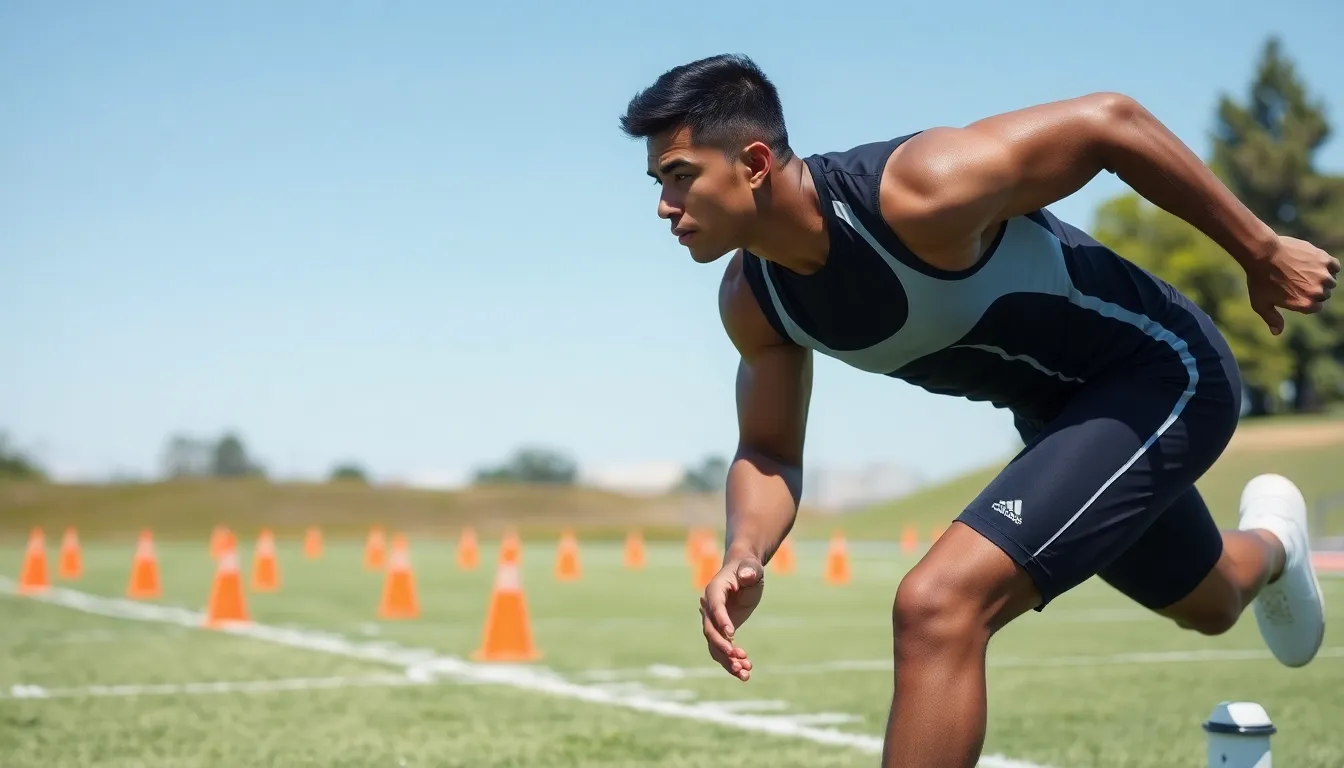Table of Contents
ToggleIn the world of sports, performance isn’t just about talent; it’s a thrilling cocktail of strategy, preparation, and a dash of good luck. Whether it’s sprinting down the track or making that game-winning shot, every athlete knows that peak performance can be the difference between glory and a faceplant on national television. And let’s be honest, nobody wants to be the next viral fail on social media.
Unlocking the secrets of sports performance can feel like trying to decipher a coach’s cryptic playbook. But fear not! With the right mindset, training techniques, and a sprinkle of humor, anyone can elevate their game. So grab your gear and get ready to explore the fascinating world of sports performance—where sweat meets science and every athlete can discover their inner champion.
Overview of Sports Performance
Sports performance encompasses a range of elements critical to athletic success. Athletes must harness their physical abilities, employ effective strategies, and engage in meticulous preparation. Both mental and physical aspects play vital roles in reaching peak performance levels.
Specific factors influence sports performance significantly. Training regimens that focus on strength, endurance, and agility help enhance overall athletic capabilities. Moreover, mental conditioning techniques, including visualization and positive reinforcement, contribute to improved focus and resilience during competitions.
Nutrition greatly impacts athletic performance. A balanced diet rich in carbohydrates, proteins, and healthy fats fuels workouts and aids recovery. Hydration also remains essential; dehydration can cripple performance and increase the risk of injury.
In addition to physical and nutritional factors, appropriate recovery methods hold importance in sustaining performance. Rest, sleep, and active recovery strategies help the body heal and grow stronger. The integration of these elements creates a comprehensive approach to sports performance improvement.
Technology increasingly aids in performance analysis. Wearable devices monitor metrics like heart rate, speed, and distance, providing valuable feedback to athletes and coaches. Utilizing this data drives targeted adjustments to training plans and competitive strategies.
Continuous evaluation and adaptation define the journey toward optimal sports performance. Athletes and their coaches work tirelessly to analyze strategies and refine techniques. With diligence and the right tools, reaching superior performance levels becomes achievable.
Factors Influencing Sports Performance

Several elements impact sports performance. These factors include physical fitness, mental toughness, nutrition, and recovery.
Physical Fitness
Physical fitness encompasses strength, endurance, flexibility, and agility. Athletes must develop tailored training programs to target these components effectively. Strength training enhances muscle power, contributing directly to performance. Endurance activities improve cardiovascular capacity, allowing athletes to sustain effort over time. Flexibility exercises reduce injury risk and enhance movement efficiency. Agility drills increase response time and overall coordination. Regular assessment and adjustment of fitness routines ensure that each athlete meets their unique goals and performance needs.
Mental Toughness
Mental toughness defines an athlete’s ability to handle pressure, overcome obstacles, and maintain focus. Developing this trait involves strategies like visualization, self-talk, and goal setting. Visualization techniques help athletes mentally rehearse successful performances. Positive self-talk reinforces confidence during challenging moments. Setting specific, measurable goals provides motivation and direction. Adopting a growth mindset empowers athletes to view setbacks as opportunities for improvement. In high-stress situations, strong mental resilience often separates exceptional performers from their peers, highlighting its critical role in sports success.
Role of Nutrition in Sports Performance
Nutrition significantly impacts sports performance by fueling athletes for optimal function and recovery. Focusing on a balanced diet that includes macronutrients and micronutrients supports training and competition.
Macronutrients and Micronutrients
Carbohydrates provide the primary energy source for athletes, fueling both endurance workouts and high-intensity training sessions. Proteins play a critical role in muscle repair and recovery, especially post-exercise. Incorporating healthy fats also contributes to overall energy levels as well as hormonal balance. Alongside macronutrients, micronutrients, like vitamins and minerals, support various metabolic processes, including immune function and bone health. Iron, calcium, and vitamin D are particularly important for maintaining optimal performance levels.
Hydration Strategies
Maintaining hydration is key for peak athletic performance. Athletes should monitor fluid intake before, during, and after exercise to prevent dehydration, which can impair performance. Assessing sweat rates can guide athletes in personalizing their hydration needs. Including electrolyte-rich drinks during extended workouts helps replenish lost minerals and maintains fluid balance. Incorporating water-rich foods, such as fruits and vegetables, also enhances overall hydration strategies. Prioritizing hydration ensures that athletes stay focused and perform at their best throughout training and competition.
Impact of Training Regimens on Sports Performance
Training regimens significantly shape sports performance, affecting various aspects like strength and endurance essential for athletic success.
Strength Training
Strength training enhances physical power and muscle endurance. Athletes incorporate resistance exercises to build muscle mass and improve performance in their respective sports. Programs often include weightlifting, bodyweight exercises, and resistance bands. These activities foster improved joint stability and prevent injuries. Additionally, specific strength training can target muscle groups relevant to an athlete’s sport, increasing the effectiveness of their performance. It’s important for athletes to gradually progress in their training to maximize benefits while minimizing risks.
Endurance Training
Endurance training plays a vital role in sustaining prolonged physical activity. Athletes engage in cardio workouts, like running or cycling, to enhance cardiovascular fitness and energy efficiency. These sessions support the body’s ability to utilize oxygen more effectively during performance. Training regimens typically include longer workouts at moderate intensity intermixed with high-intensity intervals. Incremental increases in duration and intensity lead to significant improvements in endurance levels. Tailored programs help athletes prepare for the specific demands of their sport, ensuring they maintain high energy levels throughout competitions.
Technological Advances in Sports Performance
Technological advancements significantly enhance sports performance through innovation and data-driven insights.
Wearable Technology
Wearable technology has transformed athletic training and competition. Devices like fitness trackers and smartwatches monitor vital metrics such as heart rate, distance, and calories burned. Athletes can assess their performance in real-time, enabling immediate adjustments to training regimens. Integration of GPS and accelerometers provides insights into speed and movement patterns. Players harness this data to optimize workouts and prevent injuries. Coaches, too, utilize these tools to refine strategies and identify areas for improvement. Enhanced communication between athletes and coaches strengthens collaboration, leading to better performance outcomes.
Performance Analytics
Performance analytics plays a crucial role in understanding athlete capabilities. Coaches and athletes use data analytics to analyze past performances, track progress, and identify strengths and weaknesses. Techniques including video analysis capture motion and technique, while statistical models assess performance trends. The ability to analyze this information supports informed decision-making. Athletes can then focus training efforts where they matter most, ensuring efficient use of time and resources. Continuous evaluation based on analytics fosters improvement and maximizes potential in competitive environments.
Achieving peak sports performance is a dynamic journey that blends physical prowess with mental resilience and strategic planning. Athletes can unlock their full potential by focusing on tailored training, proper nutrition, and recovery methods. Embracing technology further enhances this process, offering insights that lead to informed decisions and improved outcomes.
With dedication and the right approach, anyone can elevate their performance levels. The intersection of effort and science in sports not only paves the way for individual success but also enriches the overall athletic experience. As athletes continue to push boundaries, the pursuit of excellence remains an inspiring and ever-evolving challenge.




